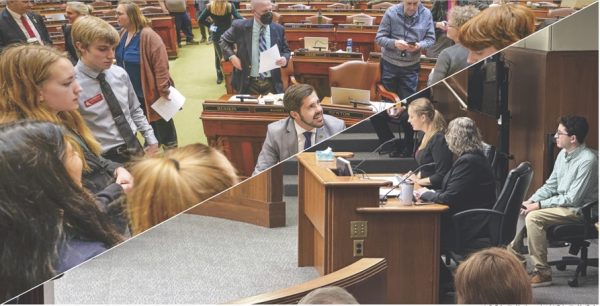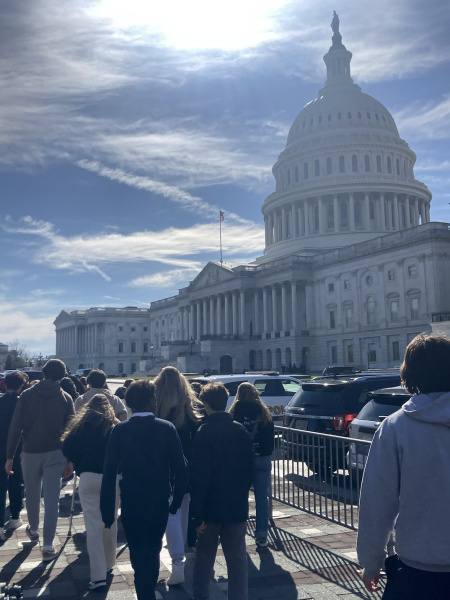Working within religious frames
“If I’m going to have a chance, I need to be concerned that all of us find justice in this world, or I can pretty much guarantee that none of us will.” Jeremiah Ellison, artist of the mural in the LearningWorks hallway and a Blake alum, uses his artistic talent to construct a narrative full of statements. He adds, “When I take a good look at the system that kills black people, I’m also going to see that the same system kills and endangers gay people, and that the same system endangers and kills immigrants, and many, many others.”
Turn the corner and bang!, it makes you stare. A young girl holds a sign that reads “my hijab is not oppressive but your stereotypes are”: the modified words of Dr. Martin Luther King Jr. Surrounding her are protestors, waving signs above their heads with rigid arms and demanding faces. Says Ellison, “Some people don’t believe anything with regards to religion, they practice and honor and achieve their value of life by some other means. I’m no religious expert. I’m just an artist, but I think you have to allow people the religious expression they choose. There is something suffocating about placing limitations on that. And life is too short to go around suffocating people.”
“The big quote there is from Dr. King, grounded so much in his social justice work, his civil rights work, in a deep, profound conviction that he was doing literally the Lord’s work,” says Scott Flemming, who for four years lead LearningWorks before assuming his role as the Director of the Office of Equity and Community Engagement. He continues by synthesizing Malala Yousafzai’s work with Dr. King’s because both have done work “within their religious traditions.”
Ellison’s mural, says Flemming, was designed to express “thoughts, hopes, aspirations, frustrations from the Blake community [on the wall].” With multiple siblings involved in LearningWorks, Ellison collaborated with the students in the program to draw a list of ideas about what it means to be a world citizen, an engaged individual, and a member of the Blake community. He says he recognizes “that the Learning Works students, who really were most of the brain power behind the wall, have lived lives that give them a particular type of politics. The wall represents people of color, achievements of women, workers’ rights, and other things that may be considered progressive. I hope that this part of the wall builds empathy, or at least upsets people enough to ask themselves why they’re upset by the images.” He continues, “Maybe they can challenge some their own narratives about the people represented on the wall. It’s good to be challenged, and it’s good to be affirmed.”
Of Malala on the wall and in his vision of politics, Ellison says that “in the United States, we find it incredibly easy to create “others” and Muslims have been placed squarely within that box. Muslim women are often paternalistically placed within a victim-villain paradox – they’re still discriminated against for the mere fact that they’re Muslim, but then you get a slew of “activists” who desperately want to rescue them from their “oppressive” religion. Ultimately, it’s disingenuous – the “protection” of muslim women becomes a pawn in the larger game of Islamophobia.”
Elsewhere at Blake and throughout its various campuses, remnants of a solely Christian school exist. Flemming gives the example of the mural in the Pillsbury Conference Room at the Hopkins Campus, where an array of portraits of famous white European thinkers and philosophers are plastered. “It starts with a person banging out a story…there’s a real commitment to storytelling [here], to individuals at Blake being able to tell their story, and I think that’s central to the work,” says Flemming. At the beginning of the mural, a man is typing on a typewriter. The paper flows out and follows the storyline of a life across the wall. Jeremiah had collected experiences that were interesting and ideal in the eyes of LearningWorks students, such as visiting outer space and giving a TedTalk.
The inclusion of protesters seeking religious justice as an important part of this “ideal life” shows that cultural freedom is held close to the heart of Blake’s philosophy. Metaphorically, Flemming explains the choice of the muralist to “[not] finish it. He intentionally left it unfinished in hope that another group when the time is right would come and add some of their touches to it as well.” He adds that there “are voices that are not heard; there are religious perspectives that are not on the wall.” There is room still to paint more in the future.
















